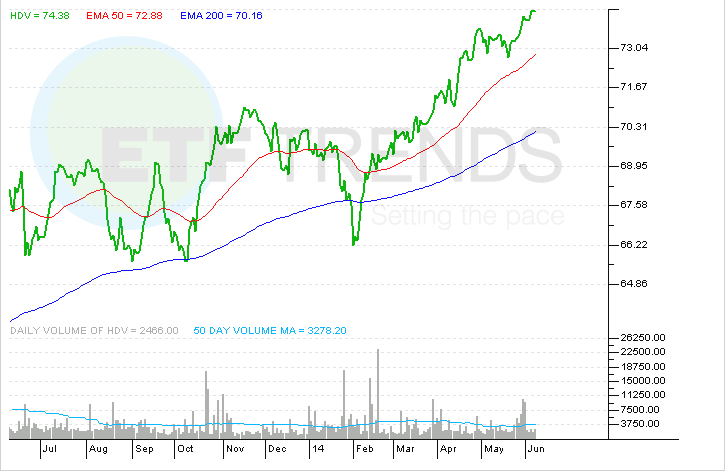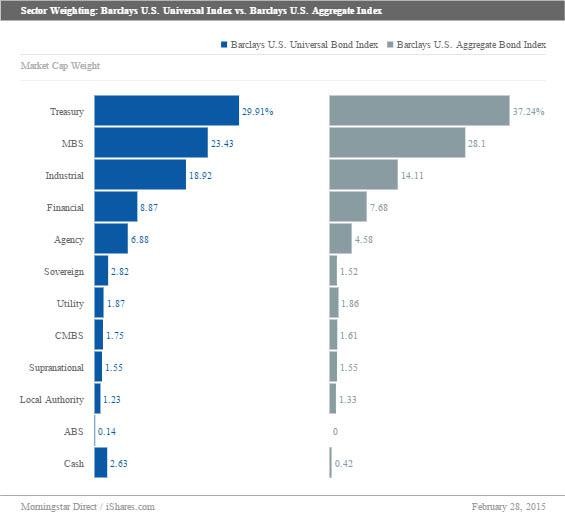Cheap Exposure To The Universal Bond Index iShares Core Total USD Bond Market ETF (NYSEARCA IUSB)
Post on: 18 Май, 2015 No Comment

By Thomas Boccellari
With yields at all-time lows, many income-seeking investors have been chasing yield, investing in everything from high-yield corporate bonds to high-quality dividend-paying stocks. However, chasing yield can often lead to increased volatility, increased probability of permanent capital loss, and returns that are more correlated to stocks. Said another way, when chasing yield, fixed-income investors often face disappointing and costly consequences.
iShares Core Total U.S. Dollar Bond Market (NYSEARCA:IUSB ) can offer a slightly higher yield while still providing correlated returns to the high-quality bond-oriented Barclays U.S. Aggregate Bond Index. IUSB tracks the Barclays U.S. Universal Bond Index. an index that includes all of the constituents in the Barclays U.S. Aggregate Bond Index plus higher-yielding assets, such as high-yield corporate bonds, and eurodollar, emerging-markets (U.S. dollar and U.S. listed) bonds, 144A securities, as well as a broader swath of commercial mortgage-backed bonds excluded from the Aggregate Index. The Aggregate Index comprises 84% of the Universal Indexs market cap, and by extending that reach across a wider range of bond sectors, the fund may be used as a core holding to get exposure to the U.S. fixed-income market.
Because IUSB invests in higher-yielding assets than funds that track the Aggregate Index, investors can expect it to deliver greater yield. As of Feb. 28, 2015, the funds yield to maturity (2.6%) was greater than that of the Aggregate Index (2.1%). Over the trailing 15-year period through February 2015, the average yield to maturity difference between the funds Universal Index benchmark and the Aggregate Index was 0.4%. Because the funds index and the Aggregate Index have had nearly identical duration since the Universal Indexs January 1990 launch, the difference in yield comes from taking on additional credit risk. As of Feb. 28, 2015, the funds duration (5.1 years) was roughly in line with the Aggregate Index’s (5.2 years).
Despite taking on additional credit risk, IUSB still has an investment-grade average credit rating of A, versus the Aggregate Indexs AA rating. Additionally, as of Feb. 28, 2015, the fund had more than 60% of its assets invested in AAA credit-quality securities versus the Aggregates 70% and less than 8% of its assets in non-investment-grade securities (average credit rating of BB+ or less). The Aggregate Index does not include non-investment-grade securities.
Investors have historically been well compensated for taking on that additional credit risk. For example, the Universal Index outperformed the Aggregate Index on a Morningstar Risk-Adjusted basis in nearly 75% of the 242 rolling five-year periods since the Universal Indexs January 1990 inception through February 2015. This shows that, more often than not, investors were better compensated for the risks taken in IUSB. Thats not to say the Universal Index will always outperform the Aggregate Index. During periods of market stress, such as the tech bubble and 2008 financial crisis, the Aggregate Index provided better returns because of its greater exposure to less-credit-sensitive assets, such as Treasuries. For example, the Universal Index underperformed the Aggregate Index over the rolling five-year periods between February 2001 and July 2003 (30 sample periods).
Cost Hurdle
While the fund currently offers a greater yield than exchange-traded funds that track the Barclays U.S. Aggregate Bond Index, investors should be aware that it may be difficult to capture all of the yield difference. While the fund has a relatively low cost (0.15% expense ratio after a 0.01% fee waiver expiring Feb. 29, 2016), that levy is greater than funds that track the Barclays U.S. Aggregate Bond Index. For example, iShares Core US Aggregate Bond (NYSEARCA:AGG ) is nearly half the cost (0.08% expense ratio after 0.01% fee waiver expiring June 30, 2015).
Compounding matters is the funds relatively small asset base ($350 million) relative to AGG ($24 billion) as of Feb. 28, 2015. Smaller asset bases can make it more expensive to trade because of larger bid-ask spreads. For example, if an investor had tried to purchase shares of the fund over the trailing week through Feb 28. 2015, she would have likely encountered an average bid-ask spread of 0.19%. However, the spread was as narrow as 0.01% and as wide as 0.80% for a few seconds.
Conversely, the same investor would have experienced only a 0.01% bid-ask spread if purchasing AGG over the same time period and the spread was consistent throughout the day. The chart below shows the bid-ask spread percentage for the fund and AGG every five seconds over the trailing week through March 4, 2015—admittedly, a single week is a small sample size, but these fluctuations in bid-ask spreads could potentially increase during periods of heavy inflows or outflows into the fund, and they highlight the potential longer-term challenge of capturing all of the funds greater yield.
In addition to wider bid-ask spreads, the funds premium discount to its net asset value may also increase the funds cost of ownership. From its June 10, 2014, inception through Feb. 28, 2015, the fund has had a daily average premium of 0.14%. Over the same time period, the fund had a discount as large as 0.23% and a premium as large as 0.50%. By contrast, AGG has had an average daily premium of 0.09%, a discount as large as 0.10%, and a premium as great as 0.37%. An investor who buys at too wide of a premium would be overpaying for the assets, which could increase her total cost of ownership.
Of course, these bid-ask spreads and premium discounts will shift over time. As a fund increases its asset base, the bid-ask spread should generally begin to narrow. This can negate the bid-ask premium percentage when first purchased and reduce the total cost of ownership. On the other hand, if bid-ask spreads stay the same or widen, the investor may get less than the value of the underlying securities, thereby increasing the total cost of ownership.
The chart below shows the total cost of buying and selling IUSB and AGG and its impact on total yield, assuming costs, bid-ask, and premium discount remain constant over the life of the investment. Even after adjusting for different hidden costs, such as bid-ask spread and premium discount, investors in IUSB get a higher annualized yield than AGG. This is an average example of an investor in IUSB who does not take any measures to minimize trading and premium costs. Investors who use limit orders and view the funds market price to NAV may be able to achieve even better results.
Tracking error was left out because it can be either additive or detractive to a funds returns. For example, IUSBs tracking error to its bogy from June 2014 to February 2015 was 0.3%. This helped the fund outperform its bogy by more than 0.2% annualized.
Index Construction

The fund tracks Barclays U.S. Universal Bond Index, which measures the total U.S. dollar-denominated, fixed-rate, taxable-bond market. The index includes corporate (investment- and non-investment grade), government, and securitized bonds. It is the parent index to the widely followed Barclays U.S. Aggregate Bond Index. As such, the Universal Index contains every constituent in the Barclays U.S. Aggregate Bond Index and also includes high-yield corporate bonds and other securities excluded by the Aggregate Index. Corporate issuers include industrial, financial, and utility companies. Securitized bonds include agency mortgage-backed securities and other asset-backed securities.
The index weights its holdings by market capitalization and rebalances at the end of each month. This gives the most heavily indebted issuers—like the U.S. government—the greatest weightings in the portfolio. The fund uses a sampling strategy to track its index and holds roughly 1,100 of its indexs 15,000 constituents. Between July 2014 and February 2015, the funds tracking error to its index was 0.3%. By comparison, AGGs tracking error to its bogy was 0.1% over the same time period.
Fees
While the funds expense ratio (0.15%) is low in absolute returns, there are ETFs that track the Barclays U.S. Aggregate Bond Index that charge as low as 0.06%. Since the funds June 10, 2014, inception, it has outperformed its benchmark by 0.2% annualized. This is mostly due to tracking error.
Alternatives
The fund is currently the only way to track the Barclays U.S. Universal Bond Index. However, investors looking for aggregate bond exposure may consider AGG (0.08% expense ratio after 0.01% fee waiver expiring June 30, 2015). Unlike IUSB, AGG only includes investment-grade securities. As of Feb. 28, 2015, AGG had a yield to maturity of 2.1% and duration of 5.1 years.
Vanguard Total Bond Market ETF (NYSEARCA:BND ) (0.08% expense ratio) is the largest ETF tracking the Barclays U.S. Aggregate Bond Index. Unlike AGG, BND excludes securities held by the Federal Reserve from its weightings. However, this hasnt had a noticeable impact on performance. Schwab US Aggregate Bond ETF (NYSEARCA:SCHZ ) (0.06% expense ratio) is the lowest-cost intermediate-term aggregate bond ETF and tracks the same index as AGG. SDPR Barclays Aggregate Bond ETF (NYSEARCA:LAG ) (0.10% expense ratio) also tracks the same index as AGG.
Investors looking for an actively managed mutual fund may consider Loomis Sayles Core Plus Bond (MUTF:NEFRX ) (0.79% expense ratio, $2,500 minimum investment), which has a Morningstar Analyst Rating of Gold. The funds managers aim to beat the Barclays U.S. Aggregate Bond Index by making active duration and credit bets. Gold-rated Metropolitan West Total Return Bond (MUTF:MWTNX ) (0.81% expense ratio, $2,500 minimum investment) is another option. Like Loomis Sayles Core Plus Bond, Metropolitan West Total Return Bonds managers try to outperform the Barclays U.S. Aggregate Bond Index. However, in a low interest-rate environment, higher fees may eat up a significant portion of these actively managed funds returns, relative to IUSB.
Disclosure: Morningstar, Inc. licenses its indexes to institutions for a variety of reasons, including the creation of investment products and the benchmarking of existing products. When licensing indexes for the creation or benchmarking of investment products, Morningstar receives fees that are mainly based on fund assets under management. As of Sept. 30, 2012, AlphaPro Management, BlackRock Asset Management, First Asset, First Trust, Invesco, Merrill Lynch, Northern Trust, Nuveen, and Van Eck license one or more Morningstar indexes for this purpose. These investment products are not sponsored, issued, marketed, or sold by Morningstar. Morningstar does not make any representation regarding the advisability of investing in any investment product based on or benchmarked against a Morningstar index.














